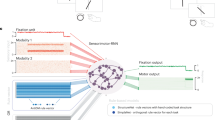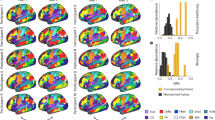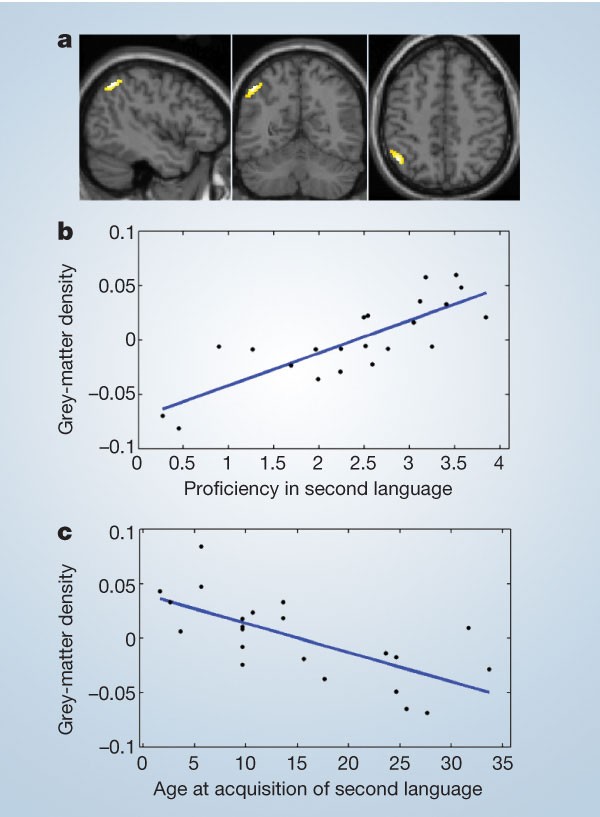Proficiency in a second language and age at acquisition affect grey-matter density.
Abstract
Humans have a unique ability to learn more than one language — a skill that is thought to be mediated by functional (rather than structural) plastic changes in the brain1. Here we show that learning a second language increases the density of grey matter in the left inferior parietal cortex and that the degree of structural reorganization in this region is modulated by the proficiency attained and the age at acquisition. This relation between grey-matter density and performance may represent a general principle of brain organization.
Similar content being viewed by others
Main
We used a whole-brain unbiased objective technique, known as voxel-based morphometry (VBM)2,3, to investigate structural plasticity in healthy right-handed English and Italian bilinguals.
To test for differences in the density of grey and white matter between bilinguals and monolinguals, we recruited 25 monolinguals who had had little or no exposure to a second language; 25 ‘early’ bilinguals, who had learned a second European language before the age of 5 years and who had practised it regularly since; and 33 ‘late’ bilinguals, who had learned a second European language between the ages of 10 and 15 years and practised it regularly for at least 5 years. All volunteers for this test were native English speakers of comparable age and level of education.
Voxel-based morphometry revealed that grey-matter density in the inferior parietal cortex was greater in bilinguals than monolinguals (Fig. 1a). This effect was significant in the left hemisphere (x = −45, y = −59, z = 48; Z-score = 7.1; P<0.05, corrected for multiple comparisons across the whole brain) and a trend was also evident in the right hemisphere (x = 56, y = −53, z = 42; Z-score = 3.4; P<0.001, uncorrected). Although increased grey-matter density in the inferior parietal cortex was common to both early and late bilinguals, the effect was greater in the early bilinguals in the left (x = −48, y = −62, z = 44; Z-score = 3.5; P<0.001, uncorrected) and right (x = 45, y = −65, z = 47; Z-score = 3.5; P<0.001, uncorrected) hemispheres. No other significant effects were detected in either grey or white matter.
a, Sagittal (x = −45), coronal (y = −59) and axial (z = 48) view of the left inferior parietal region, which has increased grey-matter density in bilinguals relative to monolinguals. b, Grey-matter density, measured as cubic millimetres of grey matter per voxel in the left inferior parietal region, as a function of second-language proficiency. Second-language proficiency was estimated for each subject from a battery of standardized neuropsychological tests, using principal component analysis (for details, see supplementary information). c, Grey-matter density, measured as for b, as a function of age at acquisition.
We next investigated whether there was a relation between brain structure and proficiency in the second language and age at acquisition. We tested 22 native Italian speakers who had learned English as a second language at an age between 2 and 34 years. Second-language reading, writing, speech comprehension and production were assessed using a battery of standardized neuropsychological tests (see supplementary information). We found that overall proficiency, as indexed by principal component analysis, correlated negatively with age at acquisition (P<0.01; r = −0.855). Remarkably, VBM revealed that second-language proficiency correlated with grey-matter density in exactly the same left inferior parietal region that we had already identified (x = −48, y = −59, z = 46; Z-score = 4.1; P<0.05, corrected after 10-mm small-volume correction; Fig. 1b). In addition, grey-matter density in this region correlated negatively with the age of acquisition of the second language (x = −50, y = −58, z = 42; Z-score = 3.2; P<0.05, corrected after 10-mm small-volume correction; Fig. 1c). There were no other significant effects in grey or white matter.
We have therefore identified an increase in the density of grey matter in the left inferior parietal cortex of bilinguals relative to monolinguals, which is more pronounced in early rather than late bilinguals, and have also shown that the density in this region increases with second-language proficiency but decreases as the age of acquisition increases.
These effects could result from a genetic predisposition to increased density, or from a structural reorganization induced by experience4. Early bilinguals probably acquire a second language through social experience, rather than as a result of a genetic predisposition. Our findings therefore suggest that the structure of the human brain is altered by the experience of acquiring a second language.
The inferior parietal region that is associated with second-language acquisition corresponds exactly to an area that has been shown by functional imaging to become activated during verbal-fluency tasks5,6. Whether grey-matter reorganization in this region is related to changes in neuropil, neuronal size, dendritic or axonal arborization will be revealed by methods other than whole-brain magnetic resonance imaging.
These results are consistent with growing evidence that the human brain changes structurally in response to environmental demands — for example, structure is already known to alter as a function of learning in domains other than language7,8. We have shown that the degree of this structural reorganization in bilinguals is correlated with their second-language performance. The relationship between grey-matter density and performance discovered here could be an example of a more general structure–function principle that extends beyond the domain of language.
References
Kim, K. H., Relkin, N. R., Lee, K. -M. & Hirsch, J. Nature 388, 171–174 (1997).
Ashburner, J. & Friston, K. J. NeuroImage 11, 805–821 (2000).
Good, C. D. et al. NeuroImage 17, 29–46 (2002).
Golestani, N., Paus, T. & Zatorre, R. J. Neuron 35, 997–1010 (2002).
Poline, J. B. et al. NeuroImage 4, 34–54 (1996).
Warburton, E. A. et al. Brain 119, 159–179 (1996).
Maguire, E. A. et al. Proc. Natl Acad. Sci. USA 97, 4398–4403 (2000).
Draganski, B. et al. Nature 427, 311–312 (2004).
Author information
Authors and Affiliations
Corresponding author
Ethics declarations
Competing interests
The authors declare no competing financial interests.
Supplementary information
Rights and permissions
About this article
Cite this article
Mechelli, A., Crinion, J., Noppeney, U. et al. Structural plasticity in the bilingual brain. Nature 431, 757 (2004). https://doi.org/10.1038/431757a
Published:
Issue Date:
DOI: https://doi.org/10.1038/431757a
This article is cited by
-
Brain gray matter morphometry relates to onset age of bilingualism and theory of mind in young and older adults
Scientific Reports (2024)
-
Language combinations of multilinguals are reflected in their first-language knowledge and processing
Scientific Reports (2023)
-
Predicting mild cognitive impairment progression to Alzheimer’s disease based on machine learning analysis of cortical morphological features
Aging Clinical and Experimental Research (2023)
-
Atypical connectivity in the cortico-striatal network in NF1 children and its relationship with procedural perceptual-motor learning and motor skills
Journal of Neurodevelopmental Disorders (2022)
-
Study protocol: a comprehensive multi-method neuroimaging approach to disentangle developmental effects and individual differences in second language learning
BMC Psychology (2022)
Comments
By submitting a comment you agree to abide by our Terms and Community Guidelines. If you find something abusive or that does not comply with our terms or guidelines please flag it as inappropriate.




